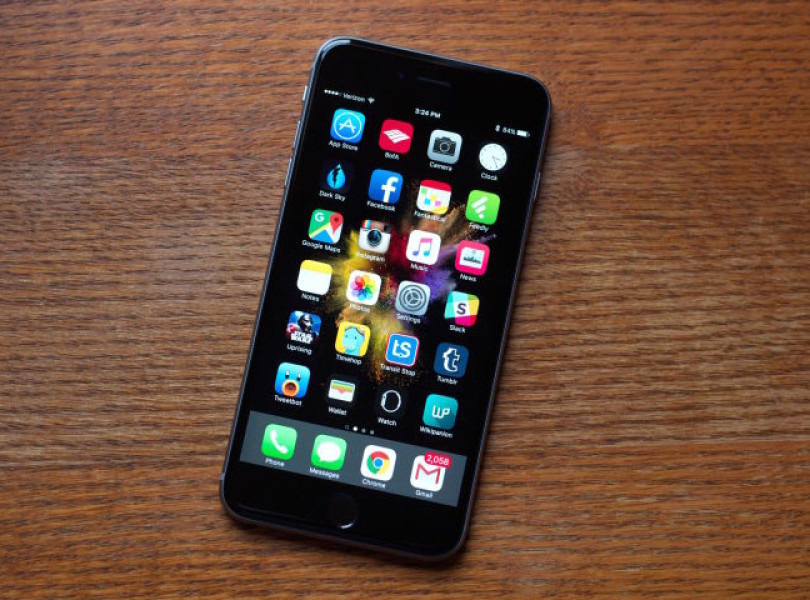Bigger gets better.
Last year’s iPhone 6 brought big, obvious change to Apple’s smartphone line: a larger, more rounded base model with a 4.7-inch display—and an even larger Plus version with a 5.5-inch stunner of a screen. While the sheer size made it more difficult to handle at times, the significant screen of the Plus made it an ideal device for portable gaming and media.

Following the usual revision cycle, the new iPhone 6s Plus takes the previous model and refines it while expanding its capabilities. From the outside, it’s very much the same phone, aside from slight size and weight increases—but the various enhancements make it a much improved device, and certainly one of the most capable big phones today.
Beyond the small “S” on the back and perhaps the new Rose Gold color, a glance at the iPhone 6s Plus won’t convince you it’s a new device. Due seemingly to the new 3D Touch screen components—and perhaps the stronger aluminum composite—the 6s Plus is 0.2mm thicker (7.3mm) and 0.7oz (6.77oz) heavier than the last model. However, unless you’re comparing them side by side, you probably won’t notice any difference on that front. And it’s still a thin and attractively minimal design that looks and feels impressively refined all around.
http://www.ign.com/videos/2015/09/25/iphone-6s-unboxing
We want to hear it.
All that said, what was great about the screen last year remains very much intact, and what wasn’t ideal about the size remains so, as well. On the former point, the 1080p display here is beautiful and bright, pumping out crisp images and serving as an excellent showcase for your media. It’s not only bigger than the iPhone 6s screen, but better as well, with greater pixel density: 401 pixels per inch on the Plus compared to 326 on the standard iPhone 6 model.
That’s still nowhere near the quad HD (or 2K) screens that have quickly become standard on flagship Android phones this year, offering even sharper displays in tiny packages. I recently reviewed Samsung’s Galaxy S6 Edge+ (shown below) and also used the Galaxy Note 5, but while both have stunning 5.7in Quad HD screens, the difference over 1080p on a pocket-sized device is barely noticeable in every-day use when screens are that pixel-dense. In fact, I find the difference between the Plus and the just-over-720p screen on the iPhone 6s much more significant than that between the Plus and Samsung’s denser 2K displays.

As far as the size, the iPhone 6s Plus remains a bit cumbersome. The standard iPhone 6s has what I’d consider nearly ideal dimensions for a medium-sized phone, assuming you don’t have tiny hands—and the Plus willfully breaks that delicate balance in favor of a larger screen. Apple hasn’t trimmed the bezel to make it more comfortable, either: in fact, the 6s Plus is slightly wider than the Galaxy Note 5, despite the smaller screen.
It’s a trade off: between the size and weight, the Plus is awkward as a one-handed phone, and is much easier to fumble. But if you use your phone mainly for media and non-spoken communication, the 6s Plus is a pretty amazing two-handed device. You have a lot more screen real estate for games, apps, videos, and web browsing; even typing is dramatically improved by the extra space. And since iOS 9 and many apps work in landscape orientation, the Plus really shows its benefits as a proper phablet. Still, it’s the first iPhone I think I’ll keep a case on long-term—for grip more than anything.

So what’s different when using iPhone 6s Plus versus the iPhone 6 Plus? Speed, first and foremost. Between the powerful new A9 processor and doubled 2GB RAM, the Plus feels so much faster than its predecessor in day-to-day use. Apps open and close quickly and can be rapidly dismissed on the switching screen, and there’s rarely a hitch in sight. Some of that has to do with iOS 9 itself, which comes pre-installed on the 6s Plus. Built with a focus on efficiency and stability, the revised OS bridges the gaps between apps, making it easier to move from one to the other and back again—and even search within them. (Plus, iOS 9 has a distinctive new system font, which is just nice, really.)
While iOS 9 hangs here and there on last year’s iPhones, it’s almost always smooth sailing on the iPhone 6s Plus. And the new-found speed manifests itself elsewhere too, as noted in my first impressions: the new Touch ID sensor is startlingly fast and accurate now, cutting down the amount of time you spend even seeing the lock screen. It’s so fast, in fact, that’s it’s borderline annoying: I’ve had to start using the pull-down Notifications menu to retrieve lock-screen alerts that disappeared before I could read them.
There’s another way that the iPhone 6s Plus can speed up your productivity: the aforementioned 3D Touch. Expanded from Force Touch on the Apple Watch, the feature uses pressure sensitivity tracking to let you press harder on the screen and bring up extra functionality. On the home screen, that means pressing into an app icon and bringing up quick access options: like your top contacts in Messages, favorites in Photos, and code redemption for the App Store.

But there’s a lot more potential within apps and games themselves, where 3D Touch can enable more complex interactions and add potential control options you can’t get from traditional tapping and swiping. Right now, it’s used for a variety of handy shortcuts and options. For example, pressing hard on a link in Safari quickly brings up a preview of the page in a bubble, while firmly pressing a date in Calendar displays your agenda. Elsewhere, applying pressure to the keyboard turns it into a trackpad for moving a cursor around text.
At this stage, a week out from the iPhone 6s Plus’ release, 3D Touch still feels like it’s barely been explored. In time, as third-party developers embrace the functionality and build experiences around it, it may well prove a crucial addition. For now, it’s only really promising, though. Empowering your thumb to do more could be a more important addition than a stylus in the long run.
Apple has long had strong smartphone cameras, focusing on lens and sensor quality even as rivals boosted their megapixel counts. For the first time in a few years, the iPhone has played the numbers game, bumping up its camera resolution to 12 megapixels, up from the eight in the previous models. Truth be told, the differences aren’t very clear in everyday shooting, especially if you do most of your viewing, editing, and sharing on your phone. I grabbed several shots on both the iPhone 6s Plus and an iPhone 6 and struggled to tell the differences in most cases. But if you zoom in on an image, particularly on a computer, you’ll typically notice finer details from the 6s Plus.


Advertisement
Advertisement
The lack of dramatic improvement isn’t really a complaint, though: the iPhone 6s Plus still takes strong photos in most scenarios, with the optical image stabilization in the larger phone allowing for better low-light results and fewer blurry throwaway shots. And selfies get a solid boost this time around: the front camera is bumped up to 5MP in the 6s Plus (from 1.2MP), and the screen can flash white when shooting, turning out well-illuminated, better-detailed results. You never know when you may need a nighttime selfie, after all.
Live Photos are a neat addition that utilize 3D Touch, as well. When enabled, the Live Photo feature grabs a bit of low-frame rate video before and after the shot, effectively creating a GIF-like clip that’s viewable by pressing hard on the image. As the father of a rambunctious toddler, I’ve already put it to great use at restaurants and playgrounds alike—but the feature degrades image quality a bit for the frames before and after the main shot, and it’s not worth keeping on for every shot you snap because it doubles the size of each photo file.

Video gets a big boost on the high end this year, thanks to the upgraded camera. Now, the back camera optionally shoots in 4K—though unless you have a screen sharp enough to view footage at that resolution, it’s not all that useful to you yet—and optical image stabilization now applies to video, as well. That makes the iPhone 6s Plus a startlingly powerful video camera for semi-serious shooting. Be warned that 4K recording eats up storage in a hurry—don’t even bother on the entry-level 16GB model.
Happily, despite more powerful components, the battery life seems about as strong as last year’s 6 Plus, despite the small capacity drop (from 2,910mAh in the 6 Plus to 2,750mAh in the 6s Plus). Most nights, after a full day of solid usage with my screen brightness very high, I’m typically left with around a 50% charge left on the phone. Even heavier game and streaming media usage has never left me with less than a 30% charge by about midnight.
The 6s Plus is as pricey as it is large, starting at $749 for the 16GB model, or just over $37/month via Apple. But that’s minuscule storage, making the $849/64GB (or $949/128GB) model a better recommendation. Unless you don’t plan to keep any substantial music, video, or apps on your phone (and you should plan to) 16GB simply isn’t enough for a modern phone.
The iPhone 6s Plus is a big, beautiful phone—with equal emphasis on both. It’s an ideal two-handed device and is fantastic for games, media, and productivity, but the size of the standard iPhone 6s make the smaller phone better suited for most users. Still, Apple’s latest Plus is super speedy, 3D Touch is a truly innovative new feature, and the camera enhancements bring various benefits. All told, it’s another excellent iPhone—although if you have the 6 Plus, an upgrade now is hardly necessary. At $849 for the 64GB model, it’s a huge investment for a huge device, but if you like a big phone, the iPhone 6s Plus stands alongside the Galaxy Note 5 as the best on the market.



